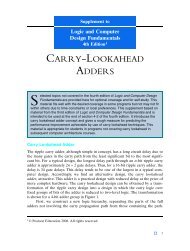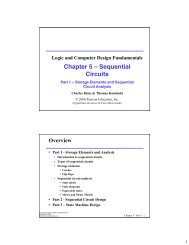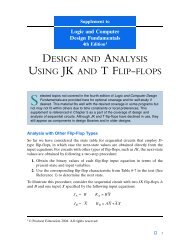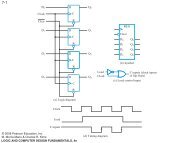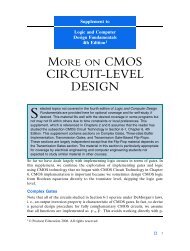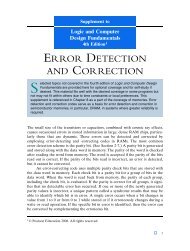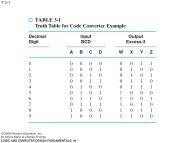Chapter 5 â Sequential Circuits
Chapter 5 â Sequential Circuits
Chapter 5 â Sequential Circuits
Create successful ePaper yourself
Turn your PDF publications into a flip-book with our unique Google optimized e-Paper software.
Example: Recognize 1101 (continued)<br />
• After one more 1, we have:<br />
• C is the state obtained<br />
when the input sequence<br />
has two "1"s.<br />
• Finally, after 110 and a 1, we have:<br />
A<br />
1/0<br />
B<br />
A<br />
1/0<br />
B<br />
1/0 0/0<br />
C<br />
1/0<br />
D 1/1<br />
C<br />
• Transition arcs are used to denote the output function (Mealy Model)<br />
• Output 1 on the arc from D means the sequence has been recognized<br />
• To what state should the arc from state D go? Remember: 1101101 ?<br />
• Note that D is the last state but the output 1 occurs for the input<br />
applied in D. This is the case when a Mealy model is assumed.<br />
<strong>Chapter</strong> 5 - Part 2 11<br />
Example: Recognize 1101 (continued)<br />
A<br />
1/0<br />
B<br />
1/0 0/0<br />
C<br />
D 1/1<br />
• Clearly the final 1 in the recognized sequence<br />
1101 is a sub-sequence of 1101. It follows a 0<br />
which is not a sub-sequence of 1101. Thus it<br />
should represent the same state reached from the<br />
initial state after a first 1 is observed. We obtain:<br />
A<br />
1/0<br />
B<br />
1/0 0/0<br />
C<br />
D<br />
1/1<br />
<strong>Chapter</strong> 5 - Part 2 12<br />
6



